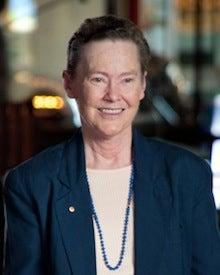SLAC Professor Emeritus Helen Quinn to Receive 2013 Sakurai Prize
SLAC Professor Emeritus Helen Quinn has been chosen to receive the 2013 J.J. Sakurai Prize for Theoretical Particle Physics, awarded each year by the American Physical Society “to recognize and encourage outstanding achievement in particle theory.”
By Lori Ann White
SLAC Professor Emeritus Helen Quinn has been chosen to receive the 2013 J.J. Sakurai Prize for Theoretical Particle Physics, awarded each year by the American Physical Society “to recognize and encourage outstanding achievement in particle theory.”
She’ll share the $10,000 award with her collaborator and co-author Roberto Peccei of the University of California, Los Angeles. The prize will be presented at the society’s April 2013 meeting in Denver.
Quinn and Peccei are being recognized for – appropriately enough – Peccei-Quinn Theory, described in the award citation as “the elegant mechanism to resolve the famous problem of strong-CP violation which, in turn, led to the invention of axions, a subject of intense experimental and theoretical investigation for more than three decades.”
CP, or charge-parity, violation has its own long history at SLAC. The BaBar experiment at SLAC showed that subatomic particles called B mesons and their antimatter counterparts, B-bar mesons, violate the plus-minus, right hand-left hand symmetries of charge and parity. These violations take place in processes governed by the weak interactions, the fundamental force of nature responsible for radioactive particle decays.
Strong-CP violation refers to CP symmetry violations occurring in processes governed by the strong interactions that rule the behavior of quarks and gluons in particles like protons or neutrons. It makes sense to think strong-CP violation would occur, Quinn said, since attempts to fit weak-CP violation into the Standard Model – the reigning description of matter and energy on quantum scales – generally result in strong interactions that break CP symmetry as well.
The problem is that strong-CP violation, if it exists at all, is much less than that argument would suggest, and physicists aren’t sure why.
This mystery is what she and Peccei sought to answer. Quinn said her own search led her to the beginning of the universe, when the laws of physics first crystallized out of the unimaginable energies of the Big Bang. “I thought, ‘How could it be that as the universe cooled, something preserved CP symmetry in the strong but not the weak interactions?’” she said.
They found a now-famous culprit, though at the time – the Peccei-Quinn theory was first published in 1977 – their search led them into unexplored territory. “It’s actually related to the Higgs mechanism,” Quinn said – the same mechanism that confers mass on fundamental particles and predicts the Higgs boson, the particle apparently found by the Large Hadron Collider this year. She and Peccei discovered that they could solve the CP problem by adding their own symmetry, now called the Peccei-Quinn symmetry, to the Higgs sector.
One result of their addition is an as-yet undiscovered particle with a very tiny mass. “Early on some of us were calling it a higglet,” Quinn said, but the proposed particle is formally called the axion, and it’s considered a candidate for dark matter. Finding this particle could support the Peccei-Quinn theory, and experiments such as the Axion Dark Matter Experiment, based at the University of Washington, are actively searching for it.
Quinn retired from her SLAC faculty position in 2010 and now focuses much of her efforts on science education as chair of a National Academy of Sciences committee that developed and released “A Framework for K-12 Science Education.” She’s leaving the fate of Peccei-Quinn symmetry and axions in the hands of experimenters, where it belongs. But she admits to being thankful that her work with Peccei has captured the interest of experimenters.
“An idea like this can die if no experimenter is interested in exploring it,” Quinn said. “It could float around in the theory community for years, but without some evidence to support it, it is unlikely to survive in the long run.”
